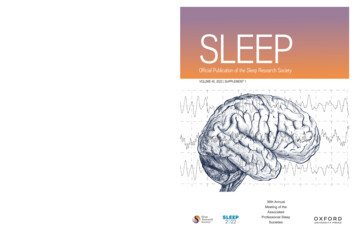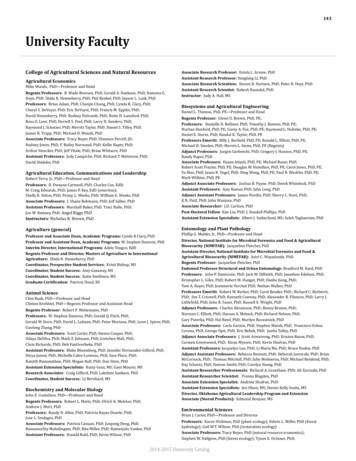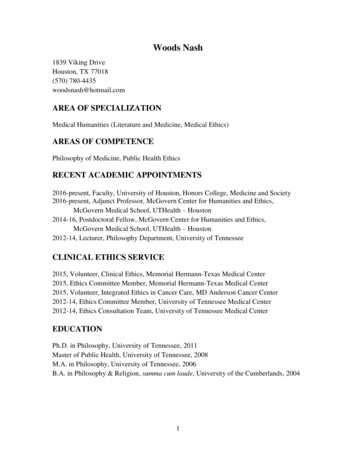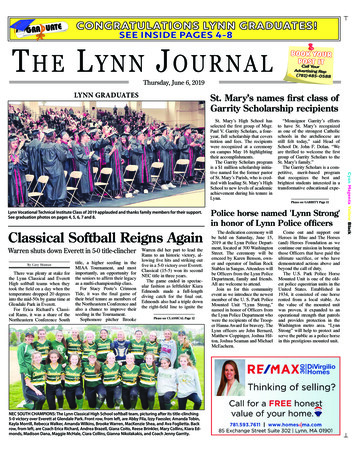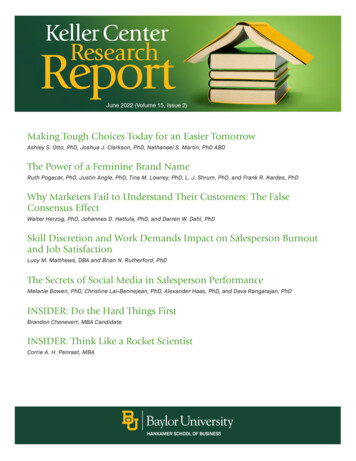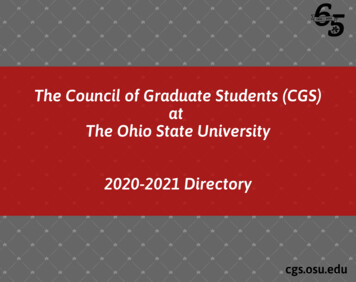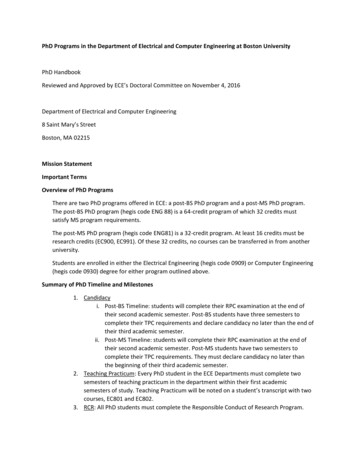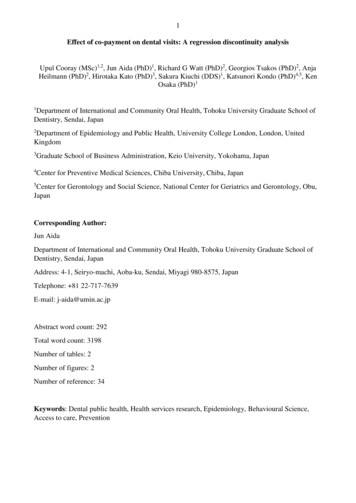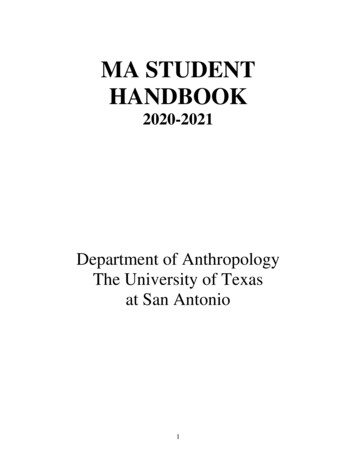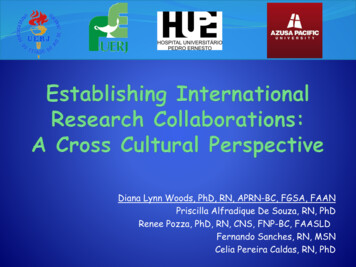
Transcription
Diana Lynn Woods, PhD, RN, APRN-BC, FGSA, FAANPriscilla Alfradique De Souza, RN, PhDRenee Pozza, PhD, RN, CNS, FNP-BC, FAASLDFernando Sanches, RN, MSNCelia Pereira Caldas, RN, PhD
With the emphasis on global health and internationalcollaborations, international research collaborationsfor nursing are essential. From a worldwideperspective, the process of building knowledge isdirectly related to the ability to disseminate thisknowledge and apply it globally.
Comparing different cultural challenges andsolutions can lead to unique ways to solvespecific social and professional problems. These solutions can be used in othercultures as a way to replicate successfulmodels and evidenced based practice toimprove nursing practice. Establishing cross cultural researchcollaborations including culturalexperiences helps deal with problemsexperienced within different cultures.
Here we present steps that contributedto the establishment of a sustainableresearch collaboration between auniversity School of Nursing in Rio deJaneiro (Universidade do Estado do Riode Janeiro) and a university School ofNursing in California, United States(Azusa Pacific University).
The presentation will focus on the experienceand insights of establishing a researchcollaboration: engaging both undergraduate and graduatestudents in research establishing common approaches to work from acollaborative international perspective future plans for sustaining this collaboration.
MAIN CAMPUS - UERJ
SON - UERJ
Methods This study is based on the self-reported experience of faculty,preceptors, and nursing students that have participated in thecollaborative partnership between Brazil and the United States(US). There is a well-established process for exchanging nursingprofessionals and students. An initial visit by the Dean andAssociate Dean of the US School of Nursing resulted in aMemorandum of Understanding (MOU) for education and researchbetween the universities. Faculty and students from a School of Nursing in California, USvisited the Brazilian university and university hospital in Rio deJaneiro, Brazil. Brazilian professors also visited the School ofNursing in California. Discussions ensued by e-mail andvideoconference.
Pedro Ernesto hospital staff with APU team
ResultsBetween 2013 and 2016, faculty members fromthe School of Nursing in California travelled toBrazil 3 times, while Brazilian faculty membersfrom Rio travelled once to the US.Preliminary studies have shown that nurses whounderstand a variety of different people aremore effective in offering ways to deal withillness and to seek wellness.
HUPE nurses visit APU
Additionally, two groups of US students havetravelled to Rio where they had the opportunityobserve nursing research and practice.
Undergraduate Reserach Collaboration
Student Research Project“Today I had the opportunity to meet with the faculty of theschool of nursing at UERJ. They were extremely welcoming andvery attentive to my needs. I received a tour of the offices andwas introduced to various staff and faculty including the DeanNV. One of the most impressive things I learned about theschool is that they publish their own journal. I was told that itwas a multilingual journal and that I could even submit anarticle about my experience in Rio for publication if I wantedto. I also had the opportunity to meet with professor OMCV,who became the first male midwife in Brazil. He currentlyoverseas much of the doctoral studies in women’s health.Overall, I was very impressed with the university not only froma personality stand point, but also with the variety of programsand degrees they offer. I can easily see why it is a leadinguniversity for nursing and nursing research in Brazil.”(Jose, APU, SON ELM student)
While health care systems are verydifferent, the population and thepressure from the growing agerontological population is a significantconsideration that is similarly sharedbetween Brazil and the US.
CareCare Serves the favela of Rocinha, the largest slum community in Riode Janeiro Clinic serves 44,000 people, 12,285 families Community divided into 11 regions, each serviced by a healthteam Health team: 1 MD, 1 RN, 1 RN technician (equivalent to an LVN),6 community health workers Enthusiastic about students doing home visits with the communityhealth workers and partnering with the health team RN’s Clinicians receive 30% salary bonus for improved patientoutcomes, families are eligible for scholarships as an incentive tomake and keep regular visits to the clinic.clinic
Santa Marta Clinic
Rhoberta Rodrigues and the Group
There are opportunities to identify different ways tosolve problems consistent with the culture of eachcountry. Observations and discussion led to new researchpossibilities in child and gerontological nursing. For example issues related to the Zika virus, anddementia syndromes, conditions common to bothcountries.
One application of a cognitive stimulation workshop for elderly peoplewith dementia, a gerontological nursing care strategy, (Souza, Bastos,Santana, & Cassiano, 2008), was implemented in Brazil. Dr. Celia Caldas, Professor at UERJ, work offers collaborative researchopportunities. Currently she and Dr. Souza are examining theapplication of Kolcaba’s comfort theory as a basis for nursing practicewhen caring for elder in acute care. Additionally she has examinedhealth promotion and wellness for elders at The University Open to theThird Age (Universidade Aberta a Terceira Idade). Woods work on aging variations and ethnopharmacology (Woods,Mentes, Cadogan & Phillips, 2016) is under review as a collaborativeresearch project at UERJ.
Emylucy Paradela, Geriatrician, Polyclinica UnATI, UERJVani, Social work with two UERJ residency studentsThe interdisciplinary team atthe Geriatric Clinic is a nationalresearch project focused on optimalfunction for elders withdepression/dementia.Students are able to participate andderive their own related projects.This clinic offers several researchopportunities for both graduate andundergraduate students
Two BSN Apu studentsParticipated in theinterdisciplinaryteam geriatric clinicObserving acomprehensiveGeriatric Assessment andteam discussion
Nursing student research projectsNursing student research projects
Using similar instruments to measureoutcomes will help improve cross-culturalcomparisons (Jessen, Cruz, Tesoro & Lopes,2014), although there is considerable researchwork related to the cultural meaning andtranslation of instruments. Ongoing videoconferencing, monthly willmaintain relationships and help to identifyareas of mutual interest for research.
Future Plans Identify funding sources Setting up the infrastructure for Graduatestudents to participate in research. Theopportunities are available. Potential Collaborations Graduate Students and Teachers Comparison between populations – For example,Gerontological populations
Diana Lynn Woods, PhD, RN, APRN-BC, FGSA, FAAN Priscilla Alfradique De Souza, RN, PhD Renee Pozza, PhD, RN, CNS, FNP-BC, FAASLD Fernando Sanches, RN, MSN Celia Pereira Caldas, RN, PhD. . Two BSN Apu students Participated in the interdisciplinary team geriatric clinic Observing a comprehensive
